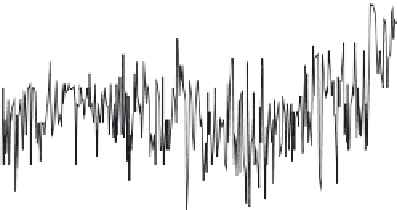Geoscience Reference
In-Depth Information
2
1.5
1
0.5
0
-0.5
-1
-1.5
-2
1500
1600
1700
1800
1900
2000
Year
Fig. 5.2
Northernhemisphereclimatetrendsover500yearsasdiscernedfrominstrumental,dendrochronologicaland
Greenlandice-corerecords.BasedonLuterbacheretal.(2004).
Against the context of the Quaternary glacial - interglacial cycles that helped
shape human evolution, the Little Ice Age is a comparatively minor blip in our
current Holocene interglacial. There are, of course, even smaller blips and regionally
there are extreme meteorological events of even shorter duration. Yet these can have
an acute impact on human activities, as we shall see in the next section. For now,
one 20th-century example will serve to illustrate the point: the dust-bowl years of the
1930s, especially 1934 and 1936, in the midwest USA. This extreme arose because
temperate continental interiors are subject to great seasonality with extremely cold
winters and hot summers. For farmers in the midwest this last was not too much of a
problem because the summer heat enabled vast quantities of water to be transported,
which fell as rain. However, the years 1934 and 1936 were both extremely hot
and
extremely dry. This, combined with poor agricultural practice, resulted in not only
crop failure but also severe soil erosion. The thing to note here is that just as in more
recent times there have been extreme regional events, so there were also in the Little
Ice Age.
Notwithstanding isolated extreme events, the Little Ice Age itself was not a period
of sustained cold. This is why perhaps there is not as much clear evidence from across
the planet as one might like to define such a period as one of great global significance.
As with the dust-bowl years, the Little Ice Age mainly shows up in specific climatic
dimensions. The 1590s were cold years but frequent subsequent years were more
notable specifically for their colder winters. However, one of the first climatic events
(albeit it a mini one) picked up by the CET record is that after the exceptionally cold
1690s there was a time of warming, around the turn of the century. The 1720s and
1730s were as warm as the late 20th century before suddenly returning to cooler
conditions in 1740.
The climate, as far as Europe was concerned, showed no discernable trend over
the next 180 years: there was nothing warmer than the 1730s and nothing cooler than
the 1690s. This shows up not only in the CET and the De Bilt series but also in the






















Search WWH ::

Custom Search